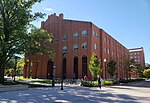William Oxley Thompson Memorial Library
1912 establishments in OhioBeaux-Arts architecture in OhioLibraries in Columbus, OhioLibrary buildings completed in 1912Library buildings completed in 1951 ... and 4 more
Library buildings completed in 1977Library buildings completed in 2009Ohio State University buildingsUniversity and college academic libraries in the United States

The William Oxley Thompson Memorial Library (commonly referred to as the Thompson Library) is the main library at Ohio State University's Columbus campus. It is the university's largest library and houses its main stacks, special collections, rare books and manuscripts, and many departmental subject libraries. The library was originally built in 1912, and was renovated in 1951, 1977, and 2009. It is named in honor of the university's fifth president, William Oxley Thompson.
Excerpt from the Wikipedia article William Oxley Thompson Memorial Library (License: CC BY-SA 3.0, Authors, Images).William Oxley Thompson Memorial Library
Neil Avenue, Columbus
Geographical coordinates (GPS) Address External links Nearby Places Show on map
Geographical coordinates (GPS)
| Latitude | Longitude |
|---|---|
| N 39.99925 ° | E -83.01485 ° |
Address
William Oxley Thompson Memorial Library (Thompson Library)
Neil Avenue 1858
43210 Columbus
Ohio, United States
Open on Google Maps









